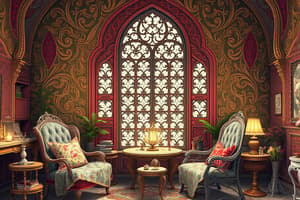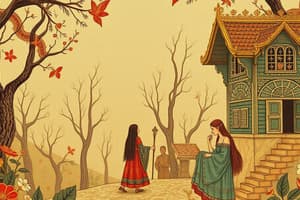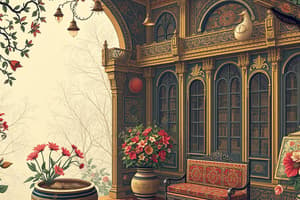Podcast
Questions and Answers
What does 'high culture' primarily emphasize?
What does 'high culture' primarily emphasize?
- A state of refinement for elites (correct)
- The artistic contributions of common folk
- Everyday living and societal structures
- Community-oriented cultural practices
According to Raymond Williams, how is culture best described?
According to Raymond Williams, how is culture best described?
- A lived practice that exists in every society (correct)
- A tool exclusively for the elites to manage society
- An organized way to establish hierarchy and power
- An abstraction that only exists in art institutions
What is a defining characteristic of folk culture?
What is a defining characteristic of folk culture?
- It is centered around high artistic achievements
- It promotes individual expression over community values
- It emerges spontaneously and reflects community needs (correct)
- It is typically created by elites in structured institutions
How does the concept of 'democratization of culture' affect social structures?
How does the concept of 'democratization of culture' affect social structures?
What was the impact of 'The Rite of Spring' in relation to social freedom?
What was the impact of 'The Rite of Spring' in relation to social freedom?
What does the erosion of high culture signify in contemporary culture?
What does the erosion of high culture signify in contemporary culture?
What was the gist of Jacques Chirac's speech regarding culture?
What was the gist of Jacques Chirac's speech regarding culture?
What is the main impact of the context in which subaltern voices are amplified?
What is the main impact of the context in which subaltern voices are amplified?
According to the concept of 'habitus culture', what factors primarily shape people's habits and behaviors?
According to the concept of 'habitus culture', what factors primarily shape people's habits and behaviors?
Which of the following statements about cultural canons is true?
Which of the following statements about cultural canons is true?
What is the function of statues and monuments in society?
What is the function of statues and monuments in society?
What does the concept of 'imagined community' imply about a nation?
What does the concept of 'imagined community' imply about a nation?
How do subcultures primarily contribute to cultural diversity?
How do subcultures primarily contribute to cultural diversity?
What is the key distinction between heritage and tradition?
What is the key distinction between heritage and tradition?
What role do tangible elements play in a culture?
What role do tangible elements play in a culture?
What does the term 'modernity' suggest about traditional practices and heritage?
What does the term 'modernity' suggest about traditional practices and heritage?
What is collective memory primarily constructed through?
What is collective memory primarily constructed through?
How do societies typically decide what to preserve or commemorate?
How do societies typically decide what to preserve or commemorate?
Which aspect characterizes behavioral aspects of culture?
Which aspect characterizes behavioral aspects of culture?
What does the term 'intangible heritage' include?
What does the term 'intangible heritage' include?
What primarily defines the legacy of heritage?
What primarily defines the legacy of heritage?
How do homemaking practices contribute to the significance of a place?
How do homemaking practices contribute to the significance of a place?
What overarching concept connects race, gender, and sexuality in society?
What overarching concept connects race, gender, and sexuality in society?
Which of the following best describes the impact of spatial segregation as discussed?
Which of the following best describes the impact of spatial segregation as discussed?
What is a key effect of culturally imposed gender roles on society?
What is a key effect of culturally imposed gender roles on society?
How do infrastructure projects like walls and checkpoints serve broader colonial goals?
How do infrastructure projects like walls and checkpoints serve broader colonial goals?
What role do public gatherings play in shaping the meaning of places?
What role do public gatherings play in shaping the meaning of places?
How do stereotypes of people of color reinforce societal structures?
How do stereotypes of people of color reinforce societal structures?
Which of the following statements best reflects intersectionality?
Which of the following statements best reflects intersectionality?
What does the construction of borders signify in a cultural context?
What does the construction of borders signify in a cultural context?
Which aspect reflects the impact of culture on the concept of place?
Which aspect reflects the impact of culture on the concept of place?
What is the primary focus of Edward Said's critique on Orientalism?
What is the primary focus of Edward Said's critique on Orientalism?
According to Gramsci's theories, how is cultural hegemony primarily maintained?
According to Gramsci's theories, how is cultural hegemony primarily maintained?
What does the concept of cultural resistance involve?
What does the concept of cultural resistance involve?
In what way does subversion manifest in folk culture and subcultures?
In what way does subversion manifest in folk culture and subcultures?
What is the significance of Spivak's idea of 'Can the Subaltern Speak?'
What is the significance of Spivak's idea of 'Can the Subaltern Speak?'
What psychological impact does spatial segregation have on individuals connected to a community?
What psychological impact does spatial segregation have on individuals connected to a community?
How can counter-narratives serve as a form of resistance?
How can counter-narratives serve as a form of resistance?
What aspect of dominant ideologies does cultural resistance aim to critique?
What aspect of dominant ideologies does cultural resistance aim to critique?
What role does the ruling class play in shaping cultural norms according to Gramsci?
What role does the ruling class play in shaping cultural norms according to Gramsci?
Flashcards
High Culture
High Culture
Culture associated with the elite, focusing on refinement and artistic labor. It is often seen as separate from the everyday culture of common people.
Culture is Ordinary
Culture is Ordinary
Culture is not limited to the elite but is found in all aspects of everyday life. It includes social norms, values, beliefs, and ways of making meaning.
Culture is Political
Culture is Political
The idea that culture is a form of power and social distinction. It can be used to create hierarchies and define social groups.
Folk Culture
Folk Culture
Signup and view all the flashcards
Culture and Freedom
Culture and Freedom
Signup and view all the flashcards
Cultural Racism
Cultural Racism
Signup and view all the flashcards
Culture as a Border
Culture as a Border
Signup and view all the flashcards
What is Heritage?
What is Heritage?
Signup and view all the flashcards
What are Traditions?
What are Traditions?
Signup and view all the flashcards
What are Tangible Elements?
What are Tangible Elements?
Signup and view all the flashcards
What are Behavioral Aspects of Culture?
What are Behavioral Aspects of Culture?
Signup and view all the flashcards
What is Collective Memory?
What is Collective Memory?
Signup and view all the flashcards
How does Modernity impact Heritage and Tradition?
How does Modernity impact Heritage and Tradition?
Signup and view all the flashcards
How do Societies Choose what to Preserve?
How do Societies Choose what to Preserve?
Signup and view all the flashcards
How do Subcultures Contribute to Diversity?
How do Subcultures Contribute to Diversity?
Signup and view all the flashcards
How do Subcultures Show Resistance?
How do Subcultures Show Resistance?
Signup and view all the flashcards
Social construction of gender
Social construction of gender
Signup and view all the flashcards
Binary system
Binary system
Signup and view all the flashcards
Intersectionality
Intersectionality
Signup and view all the flashcards
Gender role
Gender role
Signup and view all the flashcards
Racism
Racism
Signup and view all the flashcards
Heteronormativity
Heteronormativity
Signup and view all the flashcards
Homemaking
Homemaking
Signup and view all the flashcards
Spatial segregation
Spatial segregation
Signup and view all the flashcards
Spatial control
Spatial control
Signup and view all the flashcards
Unmaking a place
Unmaking a place
Signup and view all the flashcards
What is culture?
What is culture?
Signup and view all the flashcards
How does culture change?
How does culture change?
Signup and view all the flashcards
What is a nation?
What is a nation?
Signup and view all the flashcards
What is the construction of the past?
What is the construction of the past?
Signup and view all the flashcards
What do statues do?
What do statues do?
Signup and view all the flashcards
Orientalism
Orientalism
Signup and view all the flashcards
Hegemony
Hegemony
Signup and view all the flashcards
Resistance to Hegemony
Resistance to Hegemony
Signup and view all the flashcards
Counter-Narratives
Counter-Narratives
Signup and view all the flashcards
Cultural Resistance
Cultural Resistance
Signup and view all the flashcards
Subversion in Popular and Folk Culture
Subversion in Popular and Folk Culture
Signup and view all the flashcards
Can the Subaltern Speak?
Can the Subaltern Speak?
Signup and view all the flashcards
Amplifying Marginalized Voices
Amplifying Marginalized Voices
Signup and view all the flashcards
Constructing the Subaltern Other
Constructing the Subaltern Other
Signup and view all the flashcards
Study Notes
High Culture
- High culture is a culture of elites, emphasizing refinement and detaching oneself from daily struggles.
- It involves appreciating the products of refined artistic and cultural labour, which was only accessible to aristocrats.
- This culture often appears naturally refined.
- Examples include art, museums, orchestras, and Oprah's.
Why is Culture Ordinary?
- Culture is ordinary, encompassing everyday life's meanings, purposes, and expressions in different societies.
- Every society has its own shape, purposes, and meanings evident in institutions and arts.
- It's how societies define meaning and direction.
Raymond Williams's View on Culture
- Culture is not exclusive to elites or intellectuals.
- It's practiced and lived everywhere.
- Culture involves all forms of meaning production, including novels, films, theatre, art, TV, digital, and online production.
- This emphasizes the democratization of culture.
How Can Culture Be Political?
- Culture is democratized but still reflects societal power relations and social hierarchies.
- It is used to establish social distinctions.
- It is about ordinary people creating cultural forms spontaneously in pre-industrial societies.
- These cultural forms reflect the needs of the community and are considered authentic.
- Cultural differences are often used to divide 'us' from 'them', as seen in examples like Jacques Chirac's speeches about immigrants. This creates a concept of 'our' vs 'their' ways of life.
Dwight MacDonald's Critique of Mass Culture
- Mass culture leads to the erosion of high culture.
- This is evident through shifts from theatre to cinema and literature to mass-produced novels.
- Mass culture creates alienation and manipulates audiences.
Cultural Diversity and Resistance
- Subcultures offer alternative identities, values, and practices challenging mainstream norms.
- Subcultures act as forms of resistance, amplifying marginalized voices and fostering innovation.
Heritage
- Heritage includes tangible and intangible elements (such as monuments, buildings, artworks, customs) passed down through generations.
- It represents a society's values and future.
Tradition
- Traditions are practices, beliefs, customs, or rituals handed down through generations.
Tangible Aspects of Culture
- Tangible culture encompasses physical elements like art, clothing, architecture, food, tools, and technology.
- These are outward expressions of cultural values and practices.
Behavioural Aspects of Culture
- These aspects refer to individual and group actions, norms, and practices.
- Examples include communication styles, social roles, traditions, rituals, and etiquette.
Modernity and Culture
- Modernity creates "endangered" pasts that need preserving.
- It produces terms like tradition and heritage, and consequently terms like collective memory.
Collective Memory
- Collective memory is the shared narrative of a culture regarding a past that's created through narratives, symbols, and rituals.
Social Construction of Historical Narratives
- Historical narratives are shaped by social values and power structures rather than being objective accounts.
- The recording, selection, and interpretation of historical events, figures, and perspectives reflect prevailing power structures and political agendas.
Imagined Communities
- Imagined communities are social constructs where individuals feel part of a collective identity.
- Such identities are imagined because members don't meet most of their fellow members and are created through symbols, narratives, and traditions.
Race and Culture
- Race has no biological basis but is a social construct based on cultural perceptions.
- Racial identities are impacted by power structures.
- They shape laws, roles, and representations, creating hierarchies.
Individual, Interpersonal, Institutional, and Structural Racism
- Individual racism involves prejudiced beliefs, attitudes, and actions towards a particular group.
- Interpersonal racism is expressed through hate speech and exclusion.
- Institutional racism is embedded in policies and practices that favour certain groups over others.
- Structural racism is rooted in societal organizations and systems perpetuating racial inequality.
Gender and Culture
- Gender roles are socially constructed, not biologically determined, leading to imposed roles.
- Gender roles and expectations are culturally influenced.
- These expectations are evident in popular media representations (e.g. Barbie, Disney).
- These create binary systems of gender and sexuality that profoundly influence rights, legislation, workplace roles, and perpetuate stereotypes about masculinity and femininity.
Homemaking and Identity
- Practices like investing in spaces, raising structures, and marking spaces with footsteps define shared cultural identities.
- These actions reflect social values and are seen in examples such as Palestinian communities navigating Israeli infrastructure.
Orientalism
- According to Edward Said, the 'Orient' is a semi-mythical construct used to express Western superiority.
- This has influenced political and foreign policies.
Antonio Gramsci's Theories on Hegemony and Resistance
- Hegemony is when a ruling class maintains power not through force but by shaping cultural norms, beliefs, and ideologies.
- Resistance occurs when subordinate groups challenge cultural hegemony by promoting alternative ideologies.
Counter-Narratives
- Counter-narratives are alternative perspectives that challenge dominant cultural norms.
Subaltern Voices
- Subaltern voices refer to marginalized groups within a society.
- Gayatri Chakravorty Spivak's work explores how these voices are often misinterpreted or silenced in cultural narratives.
Culture and Identity
- Cultural constructions of aspects like race, gender, and nation influence how individuals are perceived and treated in society.
- Cultural meanings are embedded in places and practices that reflect and shape cultural identities.
- Mass culture lacks the authenticity of folk art and high culture, and has a simplified formulaic design that aims to please the greatest number of consumers.
Matthew Arnold's Explanation of Culture
- Culture, for Arnold, is the pursuit of refinement, detaching oneself from daily struggles to appreciate refined art and craftsmanship.
- It is developed through education and thoughtful analysis.
Habitus
- Habitus describes unconsciously acquired habits, behaviours, and ways of thinking tied to one's upbringing, social environment, and cultural norms.
How Culture Changes
- Cultural canons adapt to incorporate previously excluded art, but still reflects power dynamics within society.
Culture's Definition and Conclusion
- Culture is malleable, political, shaped by artificial social distinctions, and not neutral.
Construction of the Past
- Societies create historical narratives to legitimize their actions.
- These narratives serve interests; often reflecting dominant groups' values and perspectives, while marginalizing others.
Nation and Identity
- Nationalism is a modern phenomenon that emerged from empires.
- Shared heritage, traditions, and historical memory are key to how a nation is constructed.
Place and Culture
- Place is a space imbued with cultural meaning that is important to societies.
- Place is linked with cultural practices of remembrance and forgetting, which means place is a site of both identity formation and destruction.
Mass Culture
- Mass culture involves culturally standardized, simple, often formulaic products.
- These products are designed for mass consumption, generally by commercial companies.
Studying That Suits You
Use AI to generate personalized quizzes and flashcards to suit your learning preferences.




